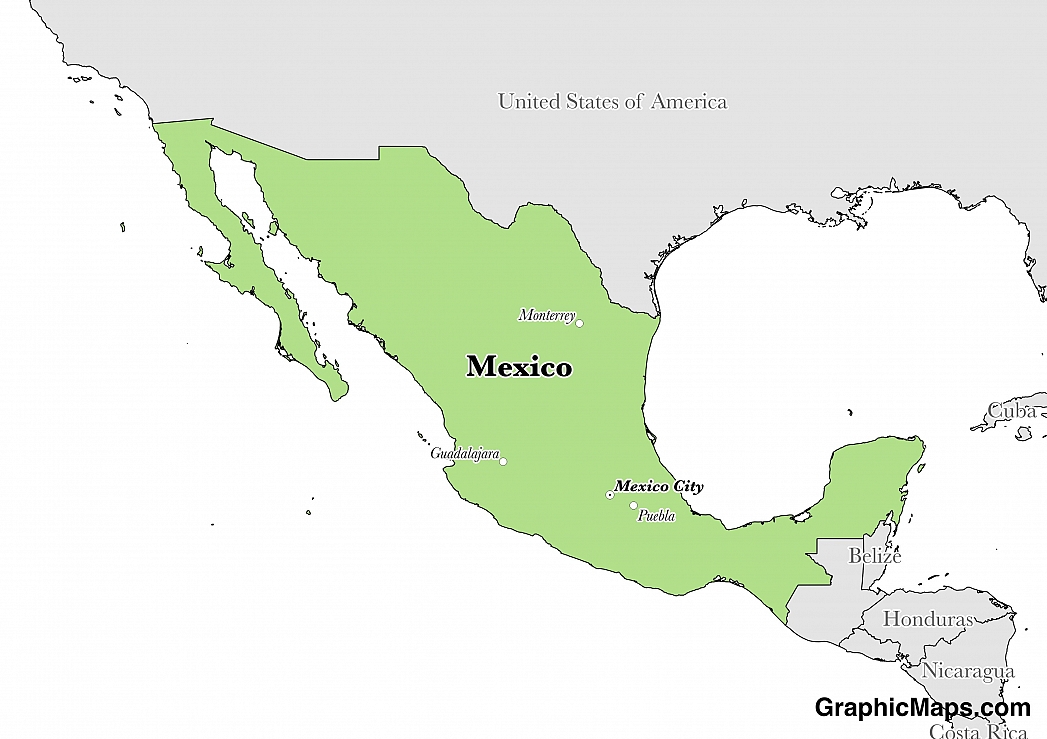Where is Mexico?
Located in North America, Mexico has a 4,389.00 km border with Belize (276 km), Guatemala (958 km) and US (3,155 km). It has a 9,330.00 km coastline. Mexico has strained water-sharing arrangements with the United States, and also experiences a high volume of illegal immigration from Central American countries.
Mexico City is the capital city of Mexico. Until January 2016, it was known as the Distrito Federal (Federal District). It was first built in 1325 making it one of the oldest capitals in the Americas. It is the most populous city in the country with a metropolitan population of more than 21.2 million. Thanks to its rich history it has a lot to offer to tourists, for example, the Ancient city of Teotihuacan and the Historic Centre of Mexico City which are both UNESCO World Heritage sites. Its climate is an Oceanic Subtropical Highland Climate due to its elevated tropical location.
Read more on Mexico's CapitalMexico is a North American country covering 1,964,375.00 km2 of which 1.04% is water and 1,943,945.00 km2 is land. This makes it the 13th largest country in the world and slightly less than three times the size of Texas. Its geographic coordinates are 23 00 N, 102 00 W and Mexico City is the capital city.
The name Mexico comes from Mexica, the largest and most powerful branch of the Aztecs.
Its ISO code is MX.
Geography
Mexico has a mean elevation of 1,111 m above sea level.
It has a varied climate, from tropical to arid. Its terrain is mostly made up of high rugged mountains, with desert, low coastal plains, and high plateaus.
Population
Mexico has a population of 123,166,749 making it the 11th largest in the world. The majority of the population can be found in the states of Jalisco and Veracruz.
Spanish is the official and most widely spoken language. The major ethnic groups reported are mestizo and Amerindian. The majority of the population is Roman Catholic.
Mexico is ethnically diverse with a large number of languages. Nonetheless, most people speak Spanish and study English as a second language. The Mexican government recognizes 68 indigenous languages which are split further into 364 dialects. The Law of Linguistic Rights protects the rights of Mexicans to use other indigenous languages in a formal context and while communicating. However, many of them are in danger of extinction. There are several phrases in Mexican Spanish used in daily conversations, though the accent differs from European Spanish. Moreover, there are at least three variations of sign language being used in Mexico.
Read more on Mexico's LanguagesThe dialing code for the country is 52.
Government
Mexico is an independent country. It declared its independence in 1810. Its constitution was last ratified in 1917.
The United States of Mexico has a presidential and a federal type of government. The head of state and commander-in-chief is the president. Power in the government is shared between the three arms of government consisting of the legislature, the judiciary, and the executive. Mexico's current constitution was adopted in 1917. The 31 Free States of Mexico are governed by the governor and their deputies. Each of the states is free and has three arms of government, each working independently. The country’s Congress is made up of two chambers: the deputies chamber has 300 members while the senator’s chamber has 200 members. In total, Congress has 500 members. The presidential general elections are held after every six years. To win the presidential elections the candidate must get the majority of the votes cast. The president can only serve for one term of 6 years. Citizens aged 18 years and above are allowed to vote in the general elections.
Read more on Mexico's GovernmentEconomy
Factoring in Purchasing Power Parity, Mexico's GDP is $2,310,000,000,000.00 (USD) with $18,900.00 (USD) per capita. This makes it the 11th largest economy and its citizens the 86th richest in the world. The currency of Mexico is the Peso (MXN).
Its major export partner is the United States. Its main exports are manufactured goods, oil and oil products, silver, and fruits. Its major import partners are the United States, China, and Japan. Its major imports include metalworking machines, steel mill products, and agricultural machinery.
Flag
The Mexican flag is comprised of tricolor stripes of green, white, and red. On the white stripe, there is a coat of arms. The coat of arms is made up of an eagle perched on a cactus with a snake in its beak and talons. The white stripe is in the middle of the flag. Green represents hope, while white is for unity, and red is for the blood shed in war. The Mexican flag has a long history behind its design. However, the flag’s colors were maintained through the years with changes only on the coat of arms.
Read more on Mexico's FlagThis page was last modified on January 17th, 2018
More on Graphicmaps

Published on 2019-11-06
What is a Trade Embargo?

Published on 2019-11-04
Which Two Countries Used to Have the Same Flag?

Published on 2019-09-16
What Is the Only Two-Sided State Flag?

Published on 2019-09-16
Which Country Flag Looks Like the Texas Flag?

Published on 2019-08-29
Flags That Resemble the US Flag

Published on 2019-08-20
